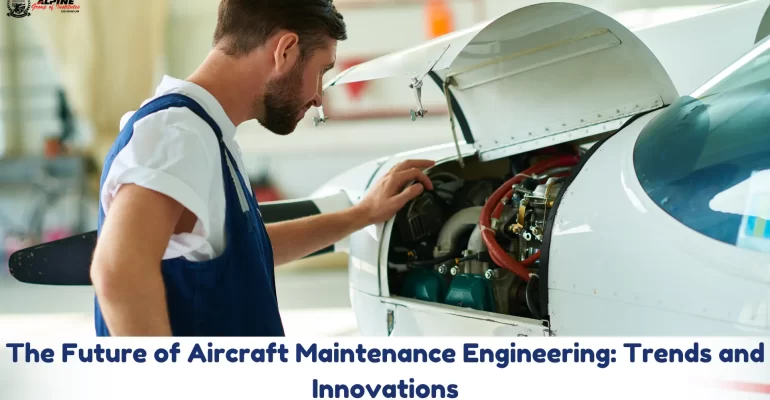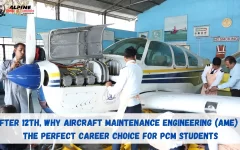The Future of Aircraft Maintenance Engineering: Trends and Innovations
2025-03-13 9:00The Future of Aircraft Maintenance Engineering: Trends and Innovations

The Future of Aircraft Maintenance Engineering: Trends and Innovations
Aircraft maintenance engineering is a vital field in the aviation industry, ensuring that aircraft remain safe, reliable, and efficient throughout their operational life. As technology continues to evolve, so too does the way aircraft maintenance is carried out. With advancements in technology, materials, and processes, the future of aircraft maintenance engineering promises to be more efficient, cost-effective, and streamlined than ever before.
Table of Contents
- Introduction
- Key Trends in Aircraft Maintenance Engineering
- Predictive Maintenance and Data Analytics
- Artificial Intelligence and Machine Learning
- Automation and Robotics in Maintenance
- Augmented Reality and Virtual Reality
- Sustainable Practices and Green Technologies
- Innovations in Aircraft Materials and Components
- The Role of Big Data in Maintenance Operations
- The Impact of 3D Printing in Aircraft Maintenance
- Challenges and Opportunities Ahead
- Conclusion
Aircraft maintenance engineering is crucial for ensuring the safety and efficiency of aircraft. The role involves regular checks, repairs, replacements, and troubleshooting of aircraft systems, engines, and components. With the ever-growing complexity of modern aircraft and the demands for improved operational efficiency, innovations in maintenance technologies are becoming increasingly important.
As the aviation industry seeks to optimize costs and improve aircraft reliability, several trends and technological innovations are transforming how aircraft are maintained. These advancements are driving efficiency, reducing downtime, and enhancing safety, all while providing new opportunities for maintenance engineers.
Key Trends in Aircraft Maintenance Engineering
a. Predictive Maintenance and Data Analytics
One of the most significant trends in aircraft maintenance engineering is predictive maintenance (PM), which leverages data analytics to predict when maintenance will be required. By monitoring various sensors and systems in real time, airlines and maintenance organizations can predict potential failures before they occur, thus preventing unplanned downtime and reducing operational costs.
Key components of predictive maintenance include:
- Sensor Networks: Monitoring key components of the aircraft, such as engines, landing gear, and avionics systems.
- Big Data Analytics: Analyzing large volumes of data collected during flight to identify patterns and potential issues.
- Condition-based Monitoring: Instead of fixed-interval checks, maintenance is performed when the system or component’s condition warrants it.
The integration of data analytics into maintenance workflows is enhancing the overall performance of aircraft and reducing the need for unnecessary inspections.
b. Artificial Intelligence (AI) and Machine Learning
Artificial intelligence and machine learning are becoming more prevalent in aircraft maintenance engineering. AI-driven systems are capable of analyzing large datasets faster and more accurately than humans, enabling predictive capabilities that can optimize maintenance schedules and detect faults in real time.
Key benefits include:
- Automated Diagnostics: AI tools can help engineers identify and diagnose issues more efficiently by scanning system logs and maintenance records.
- Learning Algorithms: Machine learning algorithms can learn from past maintenance data, improving the accuracy of fault detection and predictive maintenance systems.
With AI and machine learning, maintenance processes are becoming more autonomous, reducing human error and improving the reliability of aircraft.
c. Automation and Robotics in Maintenance
Automation and robotics are revolutionizing the way aircraft maintenance is carried out. Automated systems are being used for routine maintenance tasks such as cleaning, inspections, and parts replacement. Robotics, in particular, offers the potential to carry out complex and delicate tasks with precision, such as robotic painting, inspection of hard-to-reach areas, and even repairs.
Key applications of automation and robotics include:
- Drone Inspections: Drones are being used for visual inspections of aircraft exteriors, such as the fuselage and wings, helping engineers spot damage or wear without using scaffolding or ladders.
- Robotic Arms: Used in tasks like engine disassembly or the application of coatings and paints, ensuring uniformity and reducing human effort.
- Automated Systems for Routine Tasks: Aircraft washing, tire inspections, and minor maintenance are now being carried out by automated systems, reducing labor costs and turnaround time.
As robotics and automation continue to develop, they will further streamline maintenance operations, reducing human error and enhancing productivity.
d. Augmented Reality (AR) and Virtual Reality (VR)
Augmented Reality (AR) and Virtual Reality (VR) are emerging as powerful tools in aircraft maintenance training and repair operations. These technologies allow maintenance engineers to interact with 3D models of aircraft systems and components, providing a hands-on learning experience without the need for physical aircraft.
Key applications of AR and VR include:
- Training Simulations: VR can simulate complex maintenance scenarios, allowing engineers to practice in a virtual environment before performing real-world tasks.
- AR for On-the-Job Assistance: AR glasses or heads-up displays can provide real-time guidance to maintenance personnel during inspections or repairs, overlaying step-by-step instructions and highlighting areas of concern.
AR and VR are enhancing the skill development of maintenance engineers and improving efficiency by reducing training time and minimizing human error during repairs.
e. Sustainable Practices and Green Technologies
As environmental concerns rise, the aviation industry is adopting sustainable practices and green technologies in maintenance operations. This trend is focused on reducing the carbon footprint of aircraft, minimizing waste, and ensuring the long-term sustainability of the aviation sector.
Innovations include:
- Eco-Friendly Materials: Aircraft manufacturers are increasingly using lightweight materials and environmentally friendly coatings that are easier to maintain and require less frequent repairs.
- Energy-Efficient Systems: More aircraft systems are being designed to use less fuel and generate fewer emissions, reducing the need for frequent maintenance.
- Recycling and Waste Reduction: Maintenance engineers are being trained to handle waste disposal, such as used oils, components, and other materials, in an eco-friendly manner.
Sustainability is becoming a central focus in aircraft maintenance, aligning with the broader goals of reducing aviation’s environmental impact.
Innovations in Aircraft Materials and Components
Advancements in aircraft materials and components are directly impacting maintenance practices. New materials, such as carbon fiber composites and advanced alloys, are lighter, stronger, and more durable than traditional materials, which reduces wear and tear and extends the lifespan of aircraft.
Key innovations include:
- Self-Healing Materials: Some newer materials have self-healing properties, meaning they can repair minor cracks or damage on their own, reducing the frequency of maintenance checks.
- Smart Materials: Materials embedded with sensors can monitor their condition and report on stress levels, temperature changes, or potential damage, alerting engineers before the issue becomes critical.
These innovations are reducing maintenance needs, increasing safety, and improving overall aircraft performance.
The Role of Big Data in Maintenance Operations
Big data is revolutionizing the way maintenance is managed in the aviation industry. By collecting and analyzing vast amounts of data from aircraft systems, sensors, and maintenance logs, engineers can detect trends, predict failures, and optimize maintenance schedules. This data-driven approach helps airlines reduce costs, improve aircraft reliability, and increase safety.
Examples of big data applications include:
- Performance Monitoring: Monitoring fuel efficiency, engine health, and other performance metrics to predict potential issues.
- Maintenance Scheduling: Using data to predict when parts will need replacement or when specific maintenance tasks should be scheduled, allowing airlines to reduce downtime.
Big data plays a pivotal role in making maintenance operations more proactive and less reactive.
The Impact of 3D Printing in Aircraft Maintenance
3D printing, or additive manufacturing, is beginning to make waves in aircraft maintenance. The ability to print spare parts on demand can drastically reduce lead times and inventory costs. Engineers can print replacement parts for aircraft components that may no longer be in production or are difficult to source.
Key benefits of 3D printing include:
- On-Demand Manufacturing: Printing components as needed rather than stocking large inventories.
- Customization: Ability to produce complex, custom-made parts with high precision.
- Cost Reduction: Reducing the need for expensive tooling and shipping for rare parts.
3D printing is expected to play a significant role in reducing aircraft maintenance costs and increasing operational efficiency.
Challenges and Opportunities Ahead
While there are numerous innovations shaping the future of aircraft maintenance engineering, challenges remain:
- Cybersecurity: As aircraft become more connected and reliant on digital technologies, ensuring data security becomes increasingly important.
- Skilled Workforce: With the rapid pace of technological advancement, there will be a growing need for engineers to adapt and acquire new skills.
- Cost of Adoption: Implementing new technologies and systems can be costly, especially for smaller airlines and maintenance providers.
However, these challenges also create opportunities for growth, innovation, and further advancements in the field.
Conclusion
The future of aircraft maintenance engineering is being shaped by cutting-edge technologies such as AI, robotics, augmented reality, and big data. These innovations are transforming the way maintenance is performed, making it more efficient, cost-effective, and sustainable. As technology continues to evolve, the role of aircraft maintenance engineers will also change, requiring them to adapt to new tools and techniques.
With these advancements, the aviation industry is poised to achieve higher levels of safety, reliability, and operational efficiency, ensuring that aircraft remain in optimal condition for longer periods of time and with minimal disruption.
The future of aircraft maintenance engineering is bright, offering exciting opportunities for both engineers and the aviation industry as a whole.








